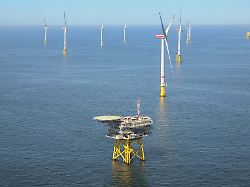Dozens of plants newly connected to the grid
Offshore wind power is picking up momentum again
01/16/2023 3:09 p.m
For a long time there was a lull in the construction of new wind turbines at sea. Dozens of systems are now going online again. The wind turbines are clearly ahead of their predecessors.
After a period of complete standstill, the construction of new offshore wind turbines picked up again last year. A total of 38 new plants with a total output of 342 megawatts (MW) went online last year. This emerges from an analysis by the consulting firm Deutsche Windguard on behalf of several industry associations, which was presented in Berlin.
At the end of the year, 1,539 wind turbines with a total capacity of 8.1 gigawatts (GW) were in operation in Germany. A year earlier there were 1,501 systems with a capacity of almost 7.8 GW. In 2021, not a single additional system was connected to the grid.
Most German offshore wind energy comes from plants in the North Sea (7 GW). Among the federal states, Lower Saxony is clearly ahead, followed by Schleswig-Holstein and Mecklenburg-Western Pomerania, to which the wind farms in the Baltic Sea with a capacity of 1.1 GW are attributed. Most wind farms are therefore at least 40 kilometers from the coast.
“Most powerful offshore wind turbines to date”
The wind turbines are getting bigger and more powerful. According to industry information, a wind turbine had an average output of almost 5.3 megawatts (MW) at the end of the year. “With 9 MW each, the systems commissioned in 2022 represent the most powerful offshore wind turbines in Germany to date,” says the report.
For the systems planned by 2025, the average output is over 11 MW. New wheels reach a height of up to 145 meters up to the hub and a rotor diameter of up to 236 meters. Germany has ramped up its offshore targets over the past year. An installed capacity of at least 30 GW by 2030, at least 40 GW by 2035 and at least 70 GW by 2045 is now planned – each with grid connection. According to the analysis, the expansion target for 2030 could be achieved with the areas currently earmarked for tender, but not the other two targets.
